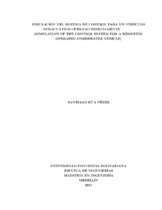Mostrar el registro sencillo del ítem
Simulación del sistema de control para un vehículo subacuático operado remotamente
| dc.contributor.advisor | V asquez Moncayo, Rafael Esteban | |
| dc.contributor.author | Rúa Pérez, Santiago | |
| dc.coverage.spatial | Seccional Medellín. Universidad Pontificia Bolivariana. Escuela de Ingeniarías. Maestría en Ingenierías | spa |
| dc.date.accessioned | 2016-08-20T17:28:59Z | |
| dc.date.available | 2016-08-20T17:28:59Z | |
| dc.date.issued | 2015 | |
| dc.identifier.uri | http://hdl.handle.net/20.500.11912/2568 | |
| dc.description | 142 p. | spa |
| dc.description.abstract | This work addresses the development of the simulation of the control system for the underwater remotely operated vehicle Visor3 using a nonlinear model of the vehicle. The 6-DOF (degrees of freedom) mathematical model of Visor3 is presented using two coordinated systems: Earth- xed and body- xed frames, and takes into account the inertia forces, centripetal and Coriolis forces and gravitational forces, and was implemented in Simulink R . Visor3 parameters were obtained using CAD models (Solid-Edge R software) and CFD simulation (ANSYS R software), within a work that was developed by a person in the J ovenes Investigadores program. The guidance, navigation and control structure (GNC) is divided into three layers: the high level or the mission planner; the mid level or the path planner; and the low level formed by the control, navigation system and sensors. This thesis addresses only the problem of the simulation of the low level control. A nonlinear model based observer is proposed for the navigation system. This observer was developed using the extended Kalman lter (EKF) which uses the linearization of the model to estimate the current state. The behavior of the observer is veri ed through simulation using Simulink R. The navigation system is a fundamental part of the closed-loop control system that will allow Visor3's operators to take advantage of more advanced vehicle's capabilities during inspection tasks of port facilities, hydroelectric dams, and oceanographic research. The main objective of the control algorithm is to execute the commands given by the operator in the surface station. These commands can be, for instance, a set-point for the vehicle's velocity or a trajectory that is to be tracked with a xed attitude. Two operation modes were de ned: planar motion control, which consist in depth regulation while the ROV is moving within the horizontal plane; and depth control in which the control system must maintain the same position in x-y while the vehicle is going up and down. To accomplish these tasks, three control algorithms were proposed: a multi-loop PID, PID with gravity compensation and LQR controller. These controllers and the nonlinear observer were tested using the 6-DOF matematical model of Visor3; four of these DOF are controllable in Visor3: surge, sway, heave, and yaw. Finally, in order to accomplish the force commanded by the control algorithm, it is necessary to determine the commands for each thruster through the thruster allocation matrix. | spa |
| dc.format.mimetype | application/pdf | |
| dc.language.iso | en | |
| dc.rights | Attribution-NonCommercial-NoDerivatives 4.0 International | * |
| dc.rights.uri | http://creativecommons.org/licenses/by-nc-nd/4.0/ | * |
| dc.subject | Robot navigation; Navigation systems; Kalman lters; PID multi-loop control; LQR control; Thruster allocation. | spa |
| dc.title | Simulación del sistema de control para un vehículo subacuático operado remotamente | spa |
| dc.title.alternative | Simulation of the control system for a remotely operated underwater vehicle | spa |
| dc.type | doctoralThesis | spa |
| dc.rights.accessRights | openAccess | spa |
| dc.type.hasVersion | publishedVersion | spa |
| dc.identifier.instname | instname:Universidad Pontificia Bolivariana | spa |
| dc.identifier.reponame | reponame:Repositorio Institucional de la Universidad Pontificia Bolivariana | spa |
| dc.identifier.repourl | repourl:https://repository.unab.edu.co/ |
Ficheros en el ítem
Este ítem aparece en la(s) siguiente(s) colección(ones)
-
Tesis de especialización, maestría y doctorado [1662]
Tesis de especialización, maestría y doctorado


